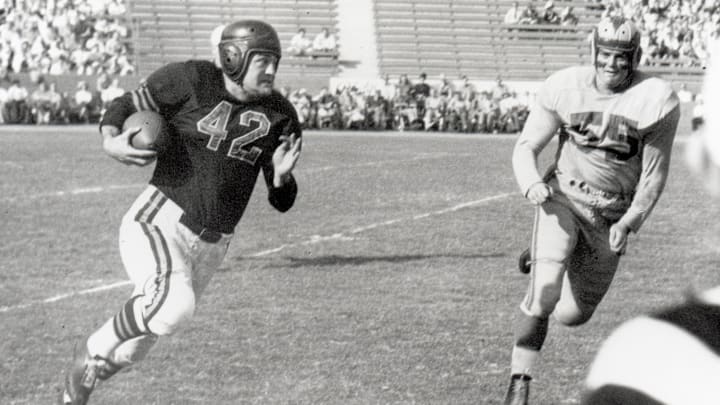We are only six Sundays away from a full spread of the first week of the NFL season, meaning that the series Chicago Bears Countdown to Kickoff continues today by examining the life and career of the best player in franchise history to don the number 42, quarterback Sid Luckman.
Sid Luckman's path from New York to the Chicago Bears
A native of Brooklyn, New York, Luckman's football career began at the nearby Erasmus High School, where he also played for the school's baseball team. Luckman led his high school squad to two All-City Championships as the team's quarterback. After a dominant high school career in the greater New York City area, Luckman elected to stay close to home and chose to attend Columbia University after fielding dozens of collegiate offers.
At Columbia, Luckman commanded head coach Lou Little's offense from the tailback position, where he was able to accumulate 2,413 yards and 20 touchdowns. However, Luckman was much more than just a member of the backfield. The future NFL great also played safety on defense and performed duties on special teams as both a punter and kicker.
Luckman was named as an All-American tailback twice and was recognized nationally as one of the premier collegiate players of his time, even appearing on the cover of Time magazine. In his final year, the Columbia standout finished third in Heisman voting.
Following his fourth collegiate season, Luckman entered the 1939 NFL Draft, just the fourth of its kind. Luckman did not have to wait long and was selected second overall by the Chicago Bears. Despite serving in a single-wing tailback system in college, team owner and coach George Halas believed that Luckman could fit well in the team's T-formation offense, and had the Columbia product serve as the team's quarterback.
Luckman becomes All-Star quarterback with the Chicago Bears
In his first season with the team, Luckman made just seven starts in 11 of the team's games while serving as a quarterback, defensive back, and punter (he would continue to play on all sides of the ball throughout his career). He was able to lead the league in yards per punt, but offensively, he had a fairly modest campaign as a rookie. The following year, however, Luckman began to take the shape of a dominant quarterback of his era and was named to his first Pro Bowl after logging nearly 1,000 passing yards, four touchdowns, and three interceptions on defense.

This breakout year would only mark the beginning of Luckman's dominance as the quarterback in the iconic T-formation. Over the next four seasons, the Columbia product was named to four First-Team All-Pro squads as well as two Pro Bowls. In this stretch he led the NFL in passing once, touchdowns once, and passer rating twice. The all-star player also brought the team to four consecutive NFL Championship games during this time where they were able to win three titles. In the 1943 championship game, Luckman passed for five touchdowns to mark the third win in just four seasons.
After the team's championship run, Luckman continued to play at a high level for another four seasons or so. From 1945 to 1948, the quarterback logged over 1,700 passing yards thrice including a dominant 2,712 yard season in 1947. He also led the league in passing touchdowns twice en route to being named to two more All-Pro teams. Luckman helped the team win another championship following the 1946 season.
Sid Luckman's retirement and Chicago Bears legacy
In his final two seasons, Luckman recorded just under 400 total yards before retiring after the 1950 season. The New York native retired as the Chicago Bears' all-time leading passer with 14,686 yards, which is still second-best in franchise history. In 12 years with the team, Luckman also recorded 137 passing touchdowns, five all-purpose touchdowns, and 17 interceptions on defense. As the team's quarterback he helped the team win four NFL titles over just seven seasons.
Following his retirement from the team, Luckman rejoined the Chicago Bears as vice presdient. He would later become an assistant coach with the team where he worked with the quarterback group. He also went on to other collegiate programs to help spread the usage of the T-formation offense.
Luckman received a number of awards and accolades after he hung up his cleats, perhaps no more impressive inductions into both the College Football Hall of Fame and the Professional Football Hall of Fame. He also had his numbered 42 jersey retired by the team shortly after his retirement.
During this era of football, it is hard to quantify a player like Luckman's true value to the game. In a time where offenses were generally stagnant, the superstar quarterback helped usher an entirely new scheme into the league. Luckman will always be remembered for commanding an offense that posted a 73-0 win against Washington, but his legacy is more related to the fact that teams then immediately tried to replicate the Bears' offense.
Luckman was a Chicago Bear through and through and was Halas's right-hand man throughout his playing career and after, so it makes a lot of sense why no other player will ever don the number 42.
